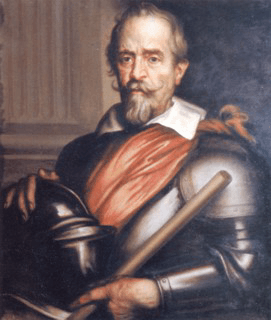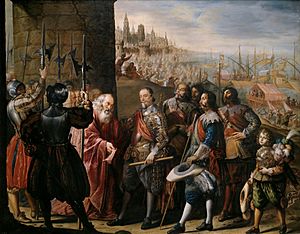Álvaro de Bazán, 2nd Marquess of Santa Cruz facts for kids

Álvaro de Bazán y Benavides (by Anthony van Dyck)
Álvaro de Bazán, 2nd Marquess of Santa Cruz, also known as Álvaro de Bazán y Benavides, was born on September 12, 1571, in Naples, Italy. He was the son of the famous Spanish admiral, Álvaro de Bazán, 1st Marquess of Santa Cruz. He passed away in 1646.
His Life and Career
Even though he wasn't as famous as his father, Álvaro II had a very successful military career. He served both on land and at sea.
He held many important positions, including:
- Governor of the Duchy of Milan (1630–1631)
- General Commander of the Army in Flanders (1631)
- A commander in the Spanish Navy
- An Army General during the Thirty Years War
- A member of Spain's important Councils of War and the State Council
- Marquess of El Viso
- Lord of Valdepeñas
- A Grandee of Spain (a very high noble title)
Important Military Actions
Álvaro II took part in many key military events:
- 1596: He helped defend Cádiz against an attack by the English fleet, sent by Queen Elizabeth I of England.
- 1602: At Sesimbra Bay, he commanded three galleys (a type of ship). However, his fleet was defeated by an English fleet.
- 1603: He became the Captain General of the Galleys for the kingdom of Naples.
- 1604: He led naval actions along the Mediterranean African Coast, near Longo Island.
- 1605-1606: He helped in the siege and capture of Estarcho and the city of Durazzo on the Albanian Coast.
- 1612: In May, he commanded the Naples fleet of galleys. Working with the Sicily fleet, they sank several galleys from Algiers.
- 1614: He helped transport moriscos (Muslims who had converted to Christianity) from Spain to North Africa. These were people who did not want to become Roman Catholics while living in Spain.
- 1622: He took part in an expedition to Africa.
- 1625: He successfully helped relieve Genoa, a city that was under attack by France and the Duchy of Savoy. This brave action was captured in a famous painting called Relief of Genoa by the Marquess of Santa Cruz.
- 1629: He became the Commander of the Mediterranean Galleys.
- 1630–1631: He was appointed Governor of the Duchy of Milan.
- 1631: He became the General Governor of the Army of Flanders.
Álvaro II married Guiomar Manrique de Lara in 1590 in Almagro, Spain. They had two sons and five daughters.
The Santa Cruz Title Over Time

Coat of Arms of the Marquessess of Santa Cruz. This title was first given by King Philip II of Spain in 1569.
The title of Marquess of Santa Cruz continued through Álvaro II's family.
- His oldest son, Mauro Alvaro, became the 3rd Marquess. He married Maria Francesca Doria from Genoa in 1627. They did not have any children who lived to adulthood.
- Because Mauro Alvaro had no surviving children, the title passed to Álvaro II's eldest sister, Maria Eugenia de Bazán y Benavides. She married Jerónimo Pimentel, who was the Viceroy of Sardinia.
- Eventually, the title of Marquess of Santa Cruz became connected to a branch of the Pimentel family. When a woman named Mencia Pimentel y Bazan married a man from the "Benavides" family, they agreed that their son would be named Francisco Diego de Bazan y Benavides. This was done to honor her ancestors and bring back the "Bazán" family name.
- Their son, Francisco de Bazan y Benavides (who died in 1680), became the Captain General of the Spanish galleys and also the Viceroy of Sicily. He always used his mother's family name, "Bazán," to show respect for his ancestors.
See also
 In Spanish: Álvaro II de Bazán para niños
In Spanish: Álvaro II de Bazán para niños

All content from Kiddle encyclopedia articles (including the article images and facts) can be freely used under Attribution-ShareAlike license, unless stated otherwise. Cite this article:
Álvaro de Bazán, 2nd Marquess of Santa Cruz Facts for Kids. Kiddle Encyclopedia.

